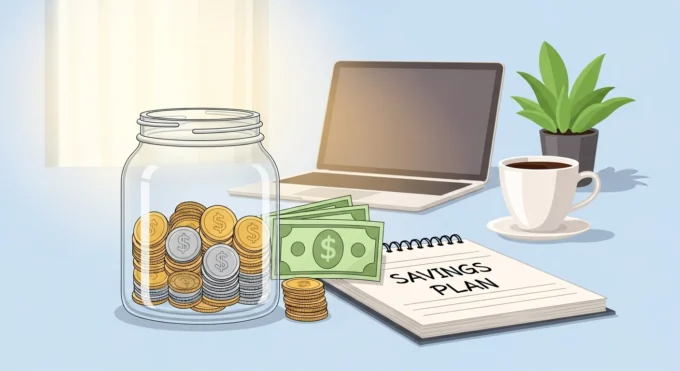Saving money sounds simple, but for many people, it triggers deep emotional stress. You might understand the importance of saving, yet feel frozen or uneasy every time you try to set money aside. This reaction is called saving anxiety a mix of fear, guilt, and pressure tied to money. The key to overcoming it lies in changing how you think about saving, not just how much you save. Let’s unpack the psychology, strategy, and mindset shifts that will help you build real financial confidence.
Understanding Saving Anxiety
Saving Anxiety happens when the act of saving triggers discomfort instead of relief. You might worry you will not have enough to cover emergencies, or you may feel guilty for not saving enough. For others, money represents security or self-worth, so saving feels emotionally charged. Recognizing this anxiety as a common and treatable issue is the first step. It is not a personal weakness it is a behavioral and emotional challenge that can be reshaped with awareness and consistent systems.
When you experience financial anxiety, your brain’s threat system activates. You may freeze and avoid your finances altogether, or spend impulsively to escape worry. Either way, anxiety prevents clear decision-making. Building financial confidence means training your brain to associate saving with safety, not fear.
The Psychology Behind Money Worry
Money is never just math it is memory, identity, and emotion. The stories we tell ourselves about money often come from childhood experiences. If you grew up around scarcity or instability, saving may feel impossible or pointless. If you grew up in a household where money meant status, saving might trigger guilt for not “living well.” These subconscious scripts shape financial behavior.
Financial anxiety thrives when we avoid our fears. Avoidance temporarily relieves stress but reinforces helplessness. The way out is through exposure and gentle structure. Facing your money with compassion, not judgment, creates the foundation for sustainable change.
Identify Your Financial Triggers
Begin by noticing when and why saving feels stressful. Do you feel anxious after checking your balance? Do you spend impulsively when you feel lonely or uncertain? Do you avoid budgeting because it reminds you of debt? Awareness of these triggers gives you control. Once you identify patterns, you can design solutions that match your emotional landscape instead of fighting against it.
For example, if checking your bank app raises anxiety, schedule a set “money check-in” time once a week instead of doing it randomly. Predictability lowers stress. If online shopping becomes a comfort response, add small friction like deleting saved cards or logging out after each session. You are not removing comfort; you are replacing it with mindfulness.
Build a Micro Safety Net
Anxiety decreases when you create visible safety. A small emergency fund, even a few hundred dollars, signals security to your nervous system. This micro-buffer is not about the number it is about proving to yourself that you can handle surprises.
Start with a goal that feels reachable, such as saving enough to cover one small unexpected expense. Keep this money in a separate account that is easy to access but not tied to your daily spending. Each time you add to this fund, your sense of control increases. Over time, the habit of saving will start to feel protective instead of punishing.
Automate Savings to Reduce Stress
Automation turns intention into action without daily decision fatigue. Set up automatic transfers from your main account to your savings right after each paycheck. Even if it is only a small percentage, consistency creates momentum.
When saving becomes automatic, your brain stops treating it as a stressful event. The goal is to build a rhythm, not to strain yourself. As your confidence grows, increase the transfer amount gradually. This slow scaling allows your emotions to adapt alongside your finances.
Create Short-Term, Achievable Goals
Large, vague goals like “save for the future” can be overwhelming. Replace them with small, clear, time-bound goals that build momentum. For example, “Save 300 in 30 days” or “Increase my emergency fund by 10 percent this month.”
Each milestone reinforces a sense of progress, which directly combats anxiety. These achievable wins train your brain to see saving as a series of victories rather than a long, exhausting journey. The satisfaction from small wins builds the confidence you need for bigger goals.
Use Friction to Prevent Impulsive Spending
When anxiety spikes, impulsive spending feels like relief. To counter this, add deliberate obstacles between you and a purchase. Delay decisions by 24 hours before buying anything non-essential. Log out of shopping sites or delete saved payment options.
This friction interrupts the emotional impulse and gives your logical mind time to step in. You will notice that most “must-have” purchases lose their power after a day. Over time, this delay rewires your brain to handle spending urges calmly.
Establish a Weekly Money Check Ritual
Checking your finances should become routine, not random. Schedule a 15-minute session each week to review your accounts, bills, and progress toward goals. Keep it brief and structured no more than 15 minutes.
This ritual transforms anxiety into information. Treat it as a neutral check-in, not a test of worth. If numbers make you nervous, visualize your progress instead of fixating on figures. For example, imagine your savings as a rising line or a growing tree. Visual cues make improvement tangible and rewarding.
Reframe Negative Money Thoughts
Saving anxiety often stems from unhelpful thoughts like “I will never get ahead” or “It’s too late to start saving.” These beliefs are cognitive distortions patterns of thinking that magnify fear.
When these thoughts arise, pause and challenge them. Replace them with practical truths, such as “I am learning to save a little better each week.” The goal is not forced positivity, but balanced realism. Over time, reframing thoughts trains your brain to view financial tasks as manageable instead of threatening.
Test and Iterate Small Experiments
Treat your financial life like a science lab. Instead of committing to massive changes, run 30-day experiments. Try automating one new savings transfer, tracking expenses for a month, or doing a “no-spend weekend.”
Small experiments reduce pressure and reveal what works best for your personality. They also build data evidence of your capability. Seeing actual results lowers anxiety far more than vague reassurance.
Seek Social Accountability
Money anxiety thrives in isolation. Share your saving goals with a trusted friend or join a community that encourages responsible money habits. Accountability provides structure and motivation, and hearing others’ stories helps you realize that saving struggles are universal.
When you know others are working toward similar goals, saving becomes less of a lonely battle and more of a shared mission. Collaboration transforms money from a private burden into a collective pursuit of stability.
When to Consider Professional Help
If financial anxiety disrupts sleep, relationships, or daily function, professional help is a smart step. A financial therapist or counselor can help you unpack emotional triggers, while a financial coach can guide practical steps. Seeking help is a sign of commitment to growth, not failure.
Combining emotional and financial support builds both resilience and results. A professional framework ensures that your progress remains steady even when stress levels fluctuate.
The 90-Day Transformation Framework
In the first week, define your saving goal and open a separate account. Automate your first small transfer. During the next 30 days, establish your weekly money ritual and remove triggers that cause impulsive spending. By the second month, increase your transfer slightly and experiment with reducing one unnecessary expense.
In the final month, evaluate your progress. Celebrate milestones, adjust systems, and set your next goal. The aim is steady improvement not perfection. Within 90 days, most people experience lower anxiety, stronger control, and a growing sense of confidence.
Building Financial Confidence Through Consistency
Confidence does not appear overnight. It grows from repeated evidence that you can manage money effectively. Each time you save, track progress, or resist an impulsive purchase, you strengthen your self-belief.
Financial confidence is not about the size of your bank account it is about your relationship with it. The goal is to reach a point where saving feels natural and empowering instead of stressful and uncertain. With time, the actions that once caused anxiety will feel automatic and rewarding.
Conclusion
Saving anxiety is a learned response and like any habit, it can be unlearned. By using structure, automation, reframing, and small wins, you can transform fear into confidence. The key is consistency over perfection.
When you create systems that respect your emotions and align with your goals, saving stops being a struggle and becomes a form of self-trust. Building financial confidence is not just about money it is about peace of mind, stability, and the quiet assurance that you are in control of your future.







Leave a comment